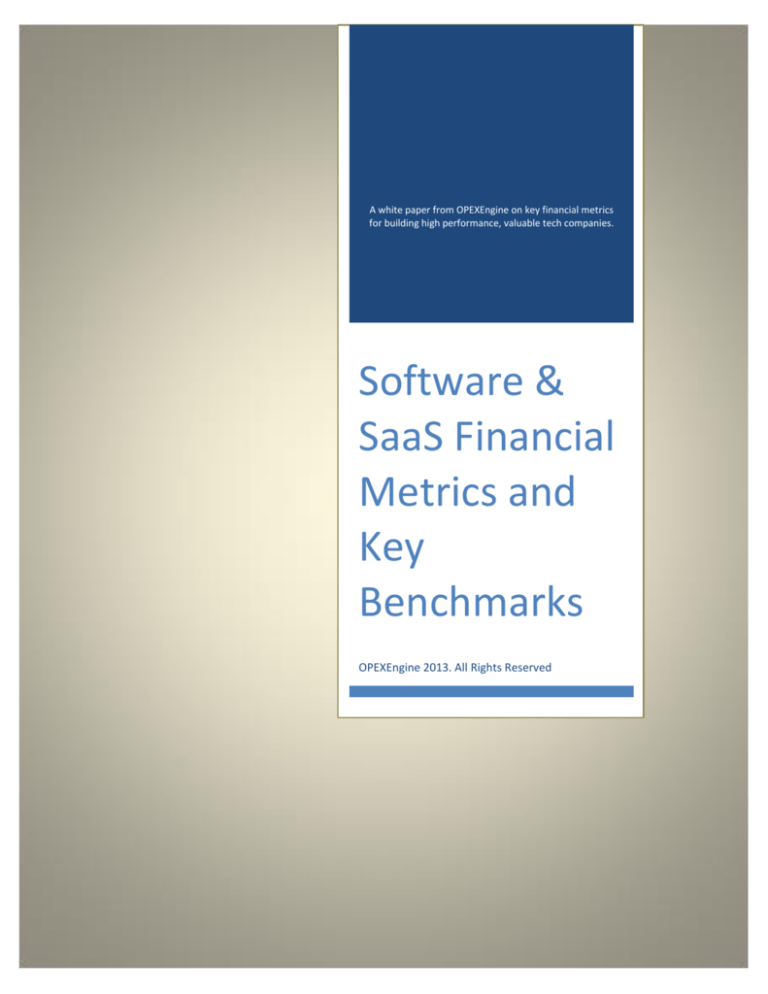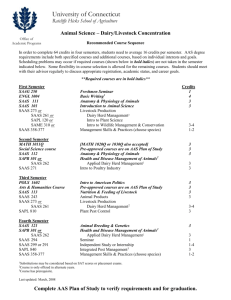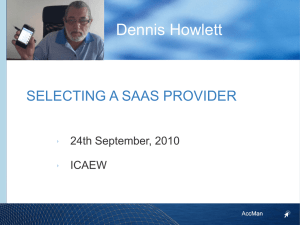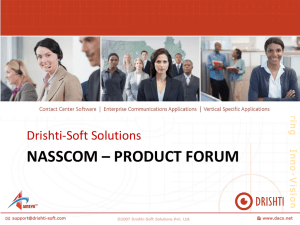
A white paper from OPEXEngine on key financial metrics
for building high performance, valuable tech companies.
Software &
SaaS Financial
Metrics and
Key
Benchmarks
OPEXEngine 2013. All Rights Reserved
Introduction
Managing the growth of a software business, whether selling traditional on-premises software
or SaaS, is far more likely to be successful when management is metrics-driven and has good
visibility into all the key performance indicators described in this paper. With greater visibility
and analysis of these metrics, companies are better able to make good decisions about efficient
and productive resource investments resulting in strong revenue growth rates and high
valuations. The metrics and data in this paper are derived from research by OPEXEngine, which
has worked with hundreds of software and SaaS companies since 2006 to benchmark their KPIs
and performance in detail.
Traditional Software versus SaaS – Different Metrics
The software industry has evolved into a number of different business models each with their
own set of performance metrics. Traditional software companies typically focus their business
modeling on financial metrics such as recognized revenues, operating expenses and profits.
Recognized revenues and bookings are viewed as the key metrics to track current and future
sales performance. This model usually has fewer moving parts to calculate business
performance than subscription businesses and as a result, fewer key performance indicators
(KPIs).
In the traditional software model, quarterly performance can be volatile, and the sales
departments in these companies drive the P&L results. The sales organization usually owns the
revenue forecast which is based on predicting the probability of closing new sales. The
forecast accuracy is dependent on the quality of sales’ estimates of whether or not contracts
will close in the period.
A recurring revenue software business, or Software as a Service (SaaS) business, usually tracks a
number of financial AND non-financial operating metrics. A valuable SaaS business is a high
growth business that continually adds and keeps subscribers, a process which is not easily
captured through traditional, point-in-time financial metrics.
The moving pieces of the SaaS model include: recurring revenues, subscriber numbers, growth
rates, revenue per customer, the cost of acquiring new customers, the cost of maintaining
existing customers, and the cost of a scalable hosting platform.
SaaS revenues are slow in building, with cash outflow far outpacing cash inflow in the early
stages. Once a SaaS business is established and takes off, it can grow very quickly as new
revenue builds onto recurring revenues, requiring efficient and scalable systems in place to
track all the moving pieces. With efficient systems in place providing managers good visibility
into the business, companies can increase investments in growth, while identifying points of
weakness to focus on and improve performance. And because in a SaaS business, each part of
the business is dependent on every other part’s performance, managers need to have visibility
into the overall picture, typically through business systems which track performance metrics.
OPEXEngine, LLC 2013. All Rights Reserved.
www.opexengine.com
October 2013
1
The forecast in a subscription business is based primarily on recurring revenues, minus some
level of customer churn, plus new subscription growth rates, which can be estimated from
past performance. The CFO of a SaaS company with the majority of revenues coming from
recurring revenues will be able to predict quarterly and annual revenues with a great deal of
accuracy. If a company knows its existing recurring revenues, and historical churn rates, as
well as indicators of new subscriptions, then the forecast is fairly predictable and is not
impacted in the short term by big, new deals coming in at the end of the quarter, or the loss of
big customers. The result is greater predictability and insight into future performance, which is
a large part of what makes the SaaS model so valuable.
Perpetual License Model
SaaS Model
Less visibility
More predictive
Forecast owned by Sales; sales-driven P&L
Forecast owned by Finance; model-driven P&L
Fewer moving parts, fast moving levers
More moving parts, slow building business
Value of customer relationship drops off
after 1st sale
Maintaining customer relationship is key:
renewals and upselling
Customer chooses and pays for all IT to
run the software
Vendor runs and maintains all software and
hardware to deliver SaaS offering
The Critical Metrics of a SaaS Growth Model
The most important metrics to track right from the start of a SaaS business fall into four primary
categories:
1. Revenue metrics
2. Customer metrics
3. Cost, Expense and Profitability metrics
4. Cash
Revenue Metrics:
Contracted Monthly or contracted annual recurring revenues (CMRR or CARR)
Revenue growth rate
Revenue per User or Subscriber (RPU), can be looked at as a monthly or annual metric
OPEXEngine, LLC 2013. All Rights Reserved.
www.opexengine.com
October 2013
2
Contracted Monthly Recurring Revenues (CMRR)
Contracted monthly or annual recurring revenues (CMRR) is generally considered the most
important revenue metric for a SaaS business as it shows the predictable, recurring revenue
components of a SaaS business. The difference between CMRR and monthly recurring revenue
(MRR) is that CMRR typically tracks revenue which is contracted indefinitely, whereas MRR may
include short-term recurring revenues that are not contracted long-term and thus may distort
the view into on-going, future revenues. However, CMRR and MRR are not defined by GAAP or
an industry standards organization, so each company may define these metrics somewhat
differently than the next company. Be cautious when benchmarking without understanding
others’ definition of CMRR and MRR.
Revenue Growth Rates
Private SaaS companies have shown a consistent trend, on average, of revenue growth rates
increasing, sometimes dramatically, as companies pass through the start-up phase after
reaching about $15million. This strong growth surge results partially from recurring revenue
momentum, but can also be attributed to increased investment in sales and marketing as cash
flows stabilize and many venture backed firms take significant additional investment to support
sales and marketing expansion. Revenue growth rates continue to be the leading indicators of
company value for both public and private SaaS companies.
Median Revenue Growth Rates
(2012 over 2011)
70.0%
60.0%
50.0%
40.0%
30.0%
20.0%
10.0%
0.0%
58.0%
30.5%
14.8%
2012 over 2011 YTY
Revenue Growth Rate
SAAS
SAAS
SAAS
COMPANIES
COMPANIES
COMPANIES
WITH REVENUE WITH REVENUE WITH REVENUE
LESS THAN
$10MM MORE THAN
$10MM
$20MM
$20MM
Source: 2013 OPEXEngine Software and SaaS Benchmarking. All Rights Reserved
RPU or revenue per subscriber is a measure of the revenue generated per subscriber. This
metric allows for the analysis of a company’s revenues and growth at a per user level, and on
an individual basis, can be used to segment profitable from unprofitable customers.
Customer Metrics:
Cost of Customer Acquisition (COCA)
OPEXEngine, LLC 2013. All Rights Reserved.
www.opexengine.com
October 2013
3
Customer Lifetime Value (CLV)
Cost of Customer Maintenance
Churn by Customer and by Dollar Value
Customer Segmentation
Cost of Customer Acquisition (COCA) and Customer Lifetime Value (CLV) are two of the most
critical SaaS metrics in determining whether a SaaS business is building a profitable business or
not. COCA includes all sales and marketing expense aimed at bringing on new customers. In
small and mid-sized companies, COCA is typically calculated as all sales and marketing expenses
from a previous quarter (or whatever time period roughly represents the average sales cycle)
divided by the number of new customers in a quarter. Customer Lifetime Value (CLV) is the
amount of profit a customer is calculated to deliver to the company over the lifetime of the
customer relationship. The simple formula for calculating CLV is:
CLV = Monthly RPU * Gross Margin
Churn
CLV is extremely powerful in helping to understand how much a company can profitably spend
to acquire and retain customers, as well as to segment profitable from unprofitable customer
groups.
In general, these metrics are less meaningful when looked at in isolation and most meaningful
in relationship to each other. For example, a high COCA may be fine if CLV is also very high,
whereas a high COCA and lower CLV would clearly be an unprofitable business. Looking at one
without the other only gives half the picture.
Cost of Maintaining a Customer usually includes the recurring cost of all engineering, support,
account management, customer service, and billing activities plus all physical infrastructure and
systems required to maintain a current customer. This metric is typically expressed per
customer, so the calculation would be:
Average Cost of Maintaining a Customer =
The recurring cost of engineering, support, account management, customer
service, and billing activities, plus all physical infrastructure and systems
required to maintain a current customer
__________________________________________________________________
All current customers
OPEXEngine, LLC 2013. All Rights Reserved.
www.opexengine.com
October 2013
4
The above describes the type of expenses involved in maintaining a subscriber, but there is no
one definition of all the items to include and each company needs to identify all these inputs
early on and track regularly. Because a SaaS business is dependent on recurring revenues and
customer renewals, new projects or systems aimed at maintaining the subscriber base will be
undertaken from time to time and it is critical to make sure those expenses are added to the
tracking of this metric.
Churn or Renewal Rates
A subscription company with a high churn rate is fundamentally less valuable than one with a
long customer life. The higher the churn rate, the slower the growth. OPEXEngine tracks
renewal rates for subscription-based products by two metrics: customer renewal rate and
dollar value renewal rate. Ideally, SaaS companies target a renewal rate in the 90+% range,
and typically, the dollar renewal rate is higher than the net customer renewal rate, due to
expansion and upselling.
REVENUE CHURN: An example of
calculating net revenue churn in monthly
recurring revenue is:
(CMRR at beginning of month minus
CMRR at end of month) minus upsell to
existing customers
_______________________________
CMRR at beginning of month
CUSTOMER CHURN: Churn can be
determined by either the gross number of
subscribers lost in a period, or by the net
change in subscribers. For example:
Gross churn
10 subscribers lost
100 subscribers
= 10% churn
OR
Net churn
10 subscribers lost
(100 original subscribers + 5 new
subscribers)
= 9.5% churn
Churn rates may vary by different customer
groups, so it is important to segment
customers by a variety of profiles, for example, by industry, size of company, deal size (whether
large deals are more or less likely to churn than small deals), by length of subscription, among
other segmentation definitions.
In general, the benchmarks show that:
early stage companies have higher churn rates than bigger SaaS companies; and
SaaS companies selling a low priced product (lower average deal size), regardless of size,
have a higher churn rate than companies selling higher priced, enterprise type software
subscriptions.
OPEXEngine, LLC 2013. All Rights Reserved.
www.opexengine.com
October 2013
5
Typically, enterprise type sales have a longer sales cycle which tends to correlate with lower
churn once the customer has made the decision to enter into a subscription relationship with
the vendor. Both the vendor and enterprise customer have invested a greater amount of time
and resource into the relationship, hence, there is less churn. Enterprise SaaS applications tend
to be integrated with complex, internal operations and other systems and in this way are more
“sticky” and difficult to displace.
Critical Cost, Expense and Profitability Metrics:
Cost of Revenue
Sales and Marketing Expense
Key cost, expense and profitability metrics include the cost of products, cost of services, hosting
expense, gross margins on products and services, sales and marketing expense, as well as R&D
and G&A expense. Some of the most critical metrics to track are the overall cost of revenue,
which for SaaS companies includes the hosting and monitoring of the application, as well as
sales and marketing expenditures which drive customer acquisition and revenue growth.
Total Cost of Revenue
Cost of Products: All direct expenses related to making or acquiring products that have
been sold, including all compensation associated with product management and
administration, plus direct overhead for the production of software or SaaS products,
including hosting and monitoring of the application.
Cost of Services: All expense associated with delivering services for the company, including
all compensation associated with services management and administration, professional
services and consulting delivery, education and training, as well as customer support.
OPEXEngine has found that early-stage SaaS companies have reduced the cost of revenue from
over 50% of revenue a few years ago to a range roughly from almost 40% to just under 30% as
revenues increase.
SaaS Companies < $10M
Average Recognized
Revenue
Cost of Revenue as a %
of Revenue
SaaS Companies $10M - $20M
SaaS Companies $20M - $50M
$6,263,747
$15,003,561
$40,808,762
36.7%
34.0%
28.1%
Source: 2013 OPEXEngine Software and SaaS Benchmarking. All Rights Reserved
OPEXEngine, LLC 2013. All Rights Reserved.
www.opexengine.com
October 2013
6
Sales and Marketing Expense from Early Stage to Public Company
SaaS companies typically spend more in Sales and Marketing than a traditional software
company because the SaaS model is all about acquiring and retaining customers. In addition,
public SaaS companies tend to maintain higher spending rates in sales and marketing rather
than reducing the percentage of revenues spent as was the case previously with traditional, onpremises software companies. Successful public SaaS companies are spending in the range of
45-55% of revenues on Sales and Marketing to continue to achieve high growth rates.
In the 2012 benchmarking, for private SaaS companies over $20 million, we saw an average
expense as a percent of revenue of 41.3%. In the benchmark of 26 public SaaS companies with
revenues under $300million, the average for sales and marketing expense was 35%, with a
range of individual companies from 20% to 63%.
Private SaaS Profit and Operating Expense as a % of Revenue
160.0%
141.2%
140.0%
123.0%
120.0%
115.5%
100.0%
80.0%
SAAS COMPANIES WITH
REVENUE LESS THAN $10MM
60.0%
SAAS COMPANIES WITH
REVENUE $10MM - $20MM
SAAS COMPANIES WITH
REVENUE MORE THAN $20MM
40.0%
20.0%
0.0%
-20.0%
-40.0%
5.2%
-4.5%
Operating
Income
-26.8%
3.3%
-1.0%
Net Income
Before Taxes
-26.9%
5.9%
6.8%
EBITDA
Total
Expenses
-24.3%
Source: 2013 OPEXEngine Software and SaaS Benchmarking. All Rights Reserved.
Cash
SaaS companies typically eat up cash quickly in the early days. The key cash metric to track is:
Net Cash from Operations
SaaS companies need to model the time it takes to get to cash flow break-even and understand
their capital requirements to get there. Expenses, such as customer acquisition costs, are paid
OPEXEngine, LLC 2013. All Rights Reserved.
www.opexengine.com
October 2013
7
up front, while revenues come in small increments on a monthly, quarterly or annual basis for
the term of the subscription. As more customers are added, the company multiplies the full
customer acquisition expense but only adds incremental revenue. Companies can speed up
getting to cash flow break even by moving from monthly billing to annual billing.
Visibility into the Business
Accurate and real time visibility through an automated financial system into a software or SaaS
company’s financial and operational data is critical to track the key performance indicators
discussed in this paper. The ability to compile the data across the organization and benchmark
it in an automated fashion allows a company to scale operations quickly and efficiently. With
the data in hand, companies have greater predictability and a better ability to forecast
revenues, expenses and cash flow than ever before. In addition, benchmarking these metrics
can provide “early warning” signals internally about performance problems which may be
corrected, once identified, to get back on track. This is especially true in the SaaS world where
executives rely on careful monitoring and benchmarking of the KPIs specific to SaaS, including
the many non-financial operating metrics. These non-financial, but critical operating metrics
would be especially difficult to track accurately manually or with simple spreadsheet tools.
The most successful software and SaaS companies today utilize real time visibility and
benchmarking of their operations to make efficient management decisions and resource
allocations, as well as providing greater predictability of business performance. Comparisons
with peer companies allow management teams to quickly identify problem areas, set targets
for improvements and to further support areas of the business that are already over-achieving
against peers. This in turn drives the strong revenue growth which underpins highly valued
companies.
About OPEXEngine
OPEXEngine works with high technology companies to develop comprehensive operating
benchmarks to drive growth and efficient use of resources. We document trends in
expense allocation, revenue growth, personnel, customer, R&D and financial metrics,
and then analyze the results to deliver detailed assessment of a company's business
model and productivity performance against peers. All individual client data is
confidential and secure, and published only as part of blinded, aggregate benchmarks.
Participating companies receive individualized benchmarking reports showing
performance against their closest peers by revenues, business models, average deal
sizes, and other characteristics.
The annual software and SaaS benchmarking survey runs typically from February through April
every year. To learn more, go to: www.opexengine.com or call at: 617-674-4218.
OPEXEngine, LLC 2013. All Rights Reserved.
www.opexengine.com
October 2013
8






